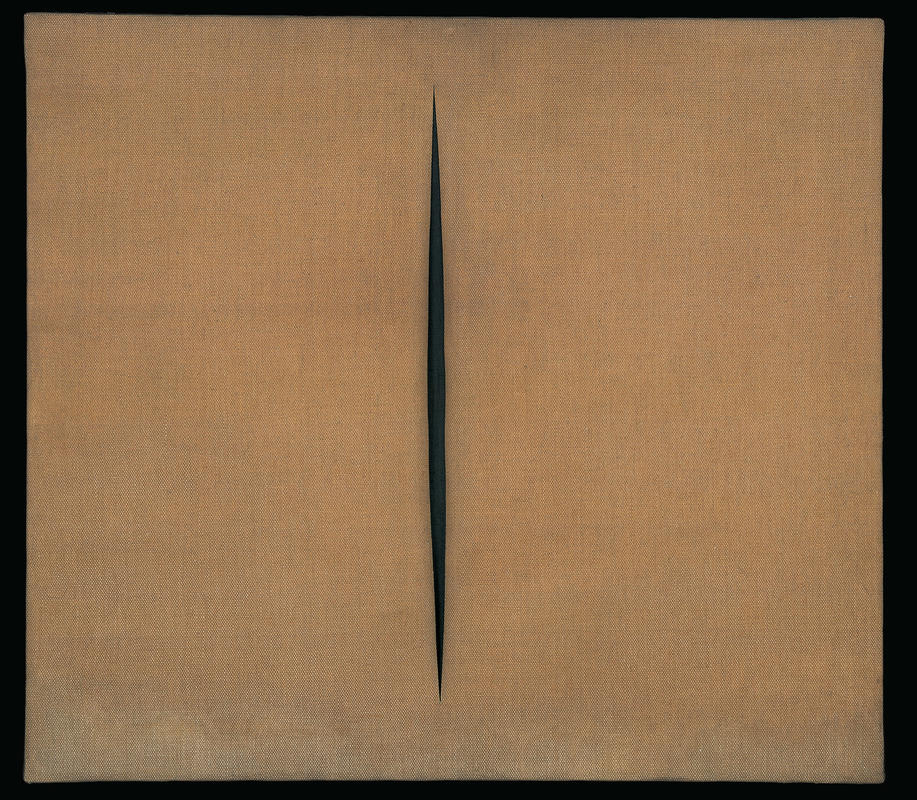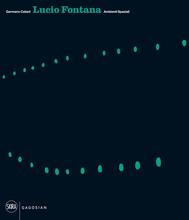More about Spatial Concept, Waiting/+1-AS/The Gardener is Arranging the Garden
- All
- Info
- Shop

Contributor
Fontana's Spatial Concept, Waiting/+1-AS/The gardener is arranging the garden is one of the Tagli, or "slash" works.
The Tagli pieces make up a miniseries in Fontana's Concetto spaziale series, which he composed in accordance with the six manifestos of Spatialism, the art movement of which he was the founder and principal author. You know that creeping feeling you get when your last manifesto just doesn't quite sum up your position, and you have to do another one? Around 1940, Fontana returned to his studio in Milan only to find that it, and all the works in it, had been destroyed by the bombs of the Allies fighting the Mussolini regime. Unfortunately, maybe like a kid on "The Wire" sucked into the street life by his environment, Fontana was an active fascist PR man for the cash. Not until the war's end in 1945 did Fontana decide that fascism wasn't the way to go—hindsight is 20/20, amirite?
Following the bombing of his studio, Fontana still enjoyed fascism, partly because of the way its Italian variety relied on art, but he wasn't going to put his life on the line for it, so he returned to his country of birth, Argentina, for a period which culminated in the White Manifesto of 1946, which, scholars claim, he himself wrote, later seeking the signatures of students for it, although he never signed it himself. There's a debate as to whether the White Manifesto is the first of the six manifestos of Spatialism, which sought to liberate art from its confinement in the two-dimensional world of the canvas. The "new state of affairs" of the postwar world, the White Manifesto says, "requires us to transcend the forms of painting, sculpture, poetry and music. We need a greater art, in accordance with the needs of the new spirit."
Writing manifestos was part of Fontana's way of overthrowing two-dimensional, representational, idealized art: the main "idea" of the manifestos was that ideas are inadequate, because they come from the conscious, rational, Apollonian mind. For Fontana, it wasn't the idea of the work, but the gesture, incorporated in the performance, which was eternal. "Today, experimental knowledge replaces imaginative knowledge," the White Manifesto continues. Still, as Peter Jackson's gallant Boromir would say, One does not simply make some cuts in a canvas and change the art world forever.
Sources
- Blessing, Jennifer. "Concetto spaziale, Attese." Guggenheim, 2018, https://www.guggenheim.org/artwork/1334.
- Brett, Guy. Force fields: phases of the kinetic. London: Hayward Gallery, 2000.
- Candela, Iria. Lucio Fontana: On the Threshold. New York: Metropolitan Museum of Art, 2019.
- Caramel, Luciano. Arte in Italia, 1945-1960. Milano: Vita e Pensiero, 1994.
- "Spatialism." Giacomo Bellini, http://www.giacomobelloni.com/styled-57/styled-15/.
- White, Anthony. "Lucio Fontana: the post-Fascist masculine figure." In Proceedings, Masculinities: Gender, Art and Popular Culture Conference. Melbourne: University of Melbourne, 2005.
- Whitfield, Sarah. Fontana. Berkeley: University of California Press, 1999.












